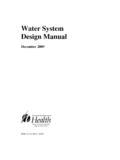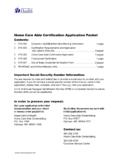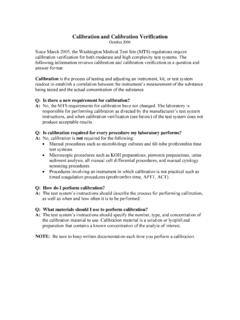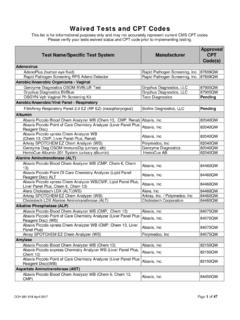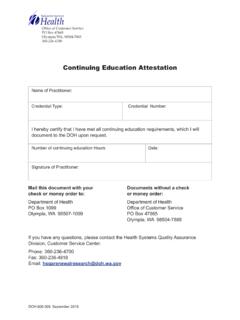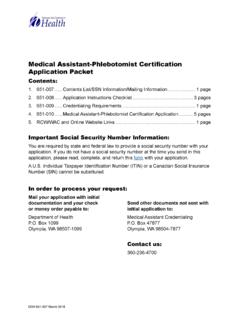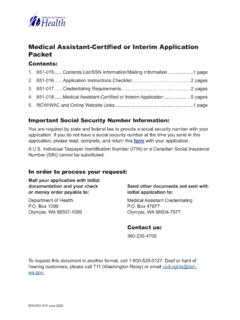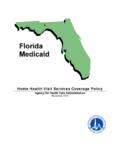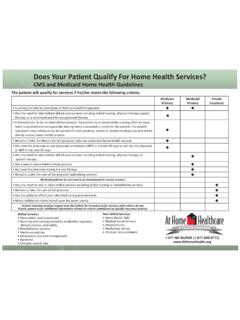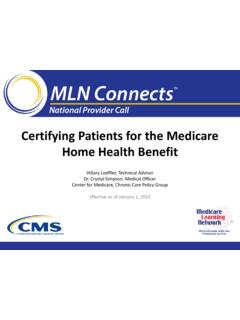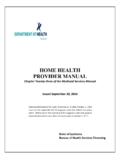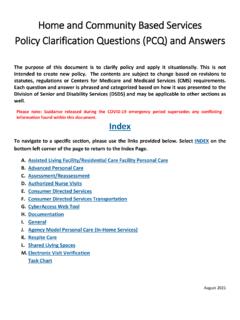Transcription of COVID-19 Guidance for Home Care, Home Health, and …
1 Updated November 22, 2021 DOH 420-299 COVID-19 Guidance for home Care, home health , and Hospice Agencies The Washington State Department of health (DOH) recognizes the need for COVID-19 infection prevention Guidance to help home care, home health , and hospice agencies that provide care to clients/patients in their homes. This work includes helping people around the house, helping them with personal care, and providing clinical care. The risk for severe illness with COVID-19 increases with age, with older adults at highest risk. It is important that you help your staff take precautions to protect their clients and themselves at this time. Before going to the home of a client Explore remote ways of providing or preparing to provide care, such as: o Telehealth and electronic charts.
2 O Plan important care services by phone video chat or on a webinar. Identify and prepare for times when staff might come into direct contact with the client: o Providing medication, meal prep in the home , cleaning, laundry, or other times where there is direct patient or item contact in the home Limit staff on hand to provide only essential care needs at this time. Ask all patients and other household members to wear a mask while the staff member is in the home . Screen patients and household members for symptoms and possible exposures to COVID-19 prior to entering the home . For In- home Clients/Patients with Known or Possible COVID-19 Set them up in a separate bedroom with a separate bathroom away from others if possible. Ensure that all people in the home have personal protective equipment to use (at least gloves and facemask) and use healthy habits, such as covering their coughs and sneezes, throwing used tissues away, and washing their hands often.
3 Make sure that pets in the home are cared for by others. Discharge Planning At discharge, give medical information about communicable diseases, advanced directives and Physician Orders for Life-Sustaining Treatment (POLST) to other service staff. If caring for clients/patients with COVID-19 , you must share infection status with the receiving service provider and transport staff before the discharge/transfer. This aligns with Medicare s Discharge Planning Requirements. Infection Control Planning for Agencies Educate patient family members about steps taken to prevent spread of COVID-19 : o Monitor and exclude ill staff and visitors, keeping in touch with loved ones from a distance (such as, phone, video call, etc.). o CDC advice for people living with someone with COVID-19 Screen staff for symptoms daily before beginning work. Develop and share policies for flexible medical leave with staff and instruct them on how and who to tell if they believe they are sick with COVID-19 .
4 Sick staff should stay home . Refer to: o CDC s Interim Guidance for Managing Healthcare Personnel with SARS-CoV-2 Infection or Exposure to SARS-CoV-2 o DOH Interim Recommendations to Mitigate health Care Worker Staffing Shortage During the COVID-19 Pandemic Identify staff at higher risk for severe COVID-19 and have them work with other clients/patients or stay home from work. Track the date and time of all visitors, health care providers, and others in the home . Schedule home visits with people who have or may have COVID-19 at the end of the day to keep risk of spreading COVID-19 during other visits. Protecting Staff and Patients Train staff on standard, contact, and droplet precautions. Provide staff with the following personal protective equipment (PPE) and provide training for proper use: Facemask (surgical mask with ear loops or mask with ties) Eye protection (for example, goggles or disposable face shield that covers front and sides of face) Gown Clean, nonsterile gloves o Fit-tested N95 Respirator if staff are working with patients/clients who have suspected or confirmed COVID-19 .
5 If you are having difficulty obtaining N95 respirators through your usual supply channels, contact your local emergency management agency. Contacts are listed here: Healthcare providers should wear a surgical face mask and eye protection, according to Secretary of health Order and CDC Guidance . CDC s Optimizing the Use of PPE provides Guidance on actions to take when PPE is in short supply or you do not have PPE. Using crisis measures is not ideal and could put health care providers at risk for disease. o Prioritize gowns for use during activities that produce splashes and sprays and during high-contact patient care activities. o Prioritize eye protection for use during activities that produce splashes and sprays and during activities where prolonged face-to-face or close contact. As possible, staff should take off PPE outside of the home . Once outside, they should use 60% alcohol-based hand sanitizer, take off face mask and throw away PPE in trash outside before they leave, and then clean their hands again.
6 Have the fewest amount of people present during aerosol-generating work (such as open suctioning of airways, nebulizer treatments, etc.) and use a higher level of protection: N95 respirator or higher, gown, gloves, and eye protection. Infection Control Guidelines for Caring for Clients/Patients with COVID-19 Wash hands often with soap and water or use 60% alcohol-based hand sanitizer. For staff tips, see Clean Hands Count for Healthcare Providers. Cough and sneeze into the elbow or into a tissue. Throw away the tissue right after use and wash hands. Clean and disinfect surfaces often. Clients/patients with COVID-19 can deteriorate quickly and it is important all caregivers and household members are able to call healthcare providers or 911. Inform staff they should call 911 if their patients/clients are experiencing any of the following symptoms: o Blue lips o Problems breathing o Change in consciousness o High fever Environmental Cleaning and Disinfection Staff should clean surfaces with soap and water or other cleaning agent to disinfect.
7 At least once during a visit , wipe high-touch areas (doorknobs, handrails, etc.) with a disinfectant. Staff should use EPA approved disinfectant from List N along with CDC Guidance for cleaning and disinfection. Diluted household bleach (at least 1000 ppm sodium hypochlorite: 5 tablespoons [1/3 cup] bleach per gallon of water or 4 teaspoons bleach per quart of water) can be used to disinfect surfaces not damaged by bleach. Staff should read the label before use of any disinfectant and follow the label s instructions. Never mix household bleach with ammonia or any other cleanser. Existing Guidance for home health and hospice On March 10, 2020 the Centers for Medicare and Medicaid Services (CMS) shared infection prevention Guidance for home health agencies. DOH advises to follow this Guidance with an emphasis on infection prevention. Although focused on home health and hospice, home care agencies may be able to implement aspects of this Guidance .
8 More help from CMS and Centers for Disease Control and Prevention (CDC): State Operations Manual Appendix B - Guidance to Surveyors: home health Agencies CDC advice: Interim Infection Prevention and Control Recommendations for Healthcare Personnel During the Coronavirus Disease 2019 ( COVID-19 ) Pandemic Interim Guidance for Implementing home Care of People Not Requiring Hospitalization for Coronavirus Disease 2019 ( COVID-19 ) Caring for Someone at home More COVID-19 Information and Resources Stay up-to-date on the current COVID-19 situation in Washington, Governor Inslee s proclamations, symptoms, how it spreads, and how and when people should get tested. See our Frequently Asked Questions for more information. A person s race/ethnicity or nationality does not, itself, put them at greater risk of COVID-19 . However, data are revealing that communities of color are being disproportionately impacted by COVID-19 . This is due to the effects of racism, and in particular, structural racism, that leaves some groups with fewer opportunities to protect themselves and their communities.
9 Stigma will not help to fight the illness. Share only accurate information to keep rumors and misinformation from spreading. WA State Department of health 2019 Novel Coronavirus Outbreak ( COVID-19 ) WA State Coronavirus Response ( COVID-19 ) Find Your Local health Department or District CDC Coronavirus ( COVID-19 ) Stigma Reduction Resources Have more questions? Call our COVID-19 Information hotline: 1-800-525-0127 Monday 6 to 10 , Tuesday Sunday and observed state holidays, 6 to 6 For interpretative services, press # when they answer and say your language. For questions about your own health , COVID-19 testing, or testing results, please contact a health care provider. To request this document in another format, call 1-800-525-0127. Deaf or hard of hearing customers, please call 711 (Washington Relay) or email
